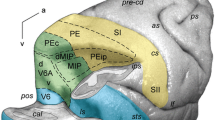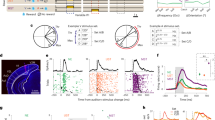Abstract
The unique anatomical and electrophysiological features of the inferior olive and its importance to cerebellar function have been recognized for decades. However, understanding the exact function of the inferior olive has been limited by the general lack of correlation between its neural activity and specific behavioral states. Electrophysiological studies in animals showed that the inferior olive response to sensory stimuli is generally invariant to stimulus properties but is enhanced by unexpected stimuli. Using functional magnetic resonance imaging in humans, we have shown that the inferior olive is activated when subjects performed a task requiring perception of visual stimuli with unpredictable timing (Xu et al. J Neurosci 26(22):5990–5995, 2006, Liu et al. J Neurophysiol 100(3):1557–1561, 2008). In the current study, subjects were scanned while passively perceiving visual and tactile stimuli that were rendered unpredictable by continuously varying interstimulus intervals (ISIs). Sequences of visual stimuli and tactile stimuli to the right hand were presented separately within the same scanning session. In addition to the activation of multiple areas in the cerebellar cortex consistent with previous imaging studies, the results show that both tactile and visual stimulation with variable ISIs were effective in activating the inferior olive. Together with our previous findings, the current results are consistent with the electrophysiological studies in animals and further support the view that the inferior olive and the climbing fiber system primarily convey the temporal information of sensory input regardless of the modality.

Similar content being viewed by others
References
Xu D, Liu T, Ashe J, Bushara KO. Role of the olivo-cerebellar system in timing. J Neurosci. 2006;26(22):5990–5.
Liu T, Xu D, Ashe J, Bushara K. Specificity of inferior olive response to stimulus timing. J Neurophysiol. 2008;100(3):1557–61.
Bell CC, Grimm RJ. Discharge properties of Purkinje cells recorded on single and double microelectrodes. J Neurophysiol. 1969;32(6):1044–55.
Llinas R. Motor control: report of the Dahlem workshop on motor control: concepts and issues, Berlin, 1989, December 3–8. In: Humphrey DR, Freund HJ, Freie Universitèat Berlin., Berlin (Germany: West). Senat. & Stifterverband fèur die Deutsche Wissenschaft, editors. Dahlem workshop reports. New York: Wiley, Chichester; 1991. p. 223–242.
Armstrong DM. Functional significance of connections of the inferior olive. Physiol Rev. 1974;54(2):358–417.
Rushmer DS, Roberts WJ, Augter GK. Climbing fiber responses of cerebellar Purkinje cells to passive movement of the cat forepaw. Brain Res. 1976;106(1):1–20.
Ishikawa K, Kawaguchi S, Rowe MJ. Actions of afferent impulses from muscle receptors on cerebellar Purkinje cells: I. Responses to muscle vibration. Exp Brain Res. 1972;15(2):177–93.
Llinas R, Baker R, Sotelo C. Electrotonic coupling between neurons in cat inferior olive. J Neurophysiol. 1974;37(3):560–71.
Llinas R, Yarom Y. Electrophysiology of mammalian inferior olivary neurones in vitro. Different types of voltage-dependent ionic conductances. J Physiol. 1981;315:549–67.
Bloedel JR, Ebner TJ. Rhythmic discharge of climbing fibre afferents in response to natural peripheral stimuli in the cat. J Physiol. 1984;352:129–46.
Eccles JC, Sabah NH, Schmidt RF, Taborikova H. Cutaneous mechanoreceptors influencing impulse discharges in cerebellar cortex: 3. In Purkinje cells by climbing fiber input. Exp Brain Res. 1972;15(5):484–97.
Gellman R, Gibson AR, Houk JC. Inferior olivary neurons in the awake cat: detection of contact and passive body displacement. J Neurophysiol. 1985;54(1):40–60.
Barmack NH, Simpson JI. Effects of microlesions of dorsal cap of inferior olive of rabbits on optokinetic and vestibuloocular reflexes. J Neurophysiol. 1980;43(1):182–206.
Winkelman B, Frens M. Motor coding in floccular climbing fibers. J Neurophysiol. 2006;95(4):2342–51.
Bloedel JR, Bracha V. Current concepts of climbing fiber function. Anat Rec. 1998;253(4):118–26.
Yarom Y, Cohen D. The olivocerebellar system as a generator of temporal patterns. Ann N Y Acad Sci. 2002;978:122–34.
Jacobson GA, Rokni D, Yarom Y. A model of the olivo-cerebellar system as a temporal pattern generator. Trends Neurosci. 2008;31(12):617–25.
Llinas RR. Inferior olive oscillation as the temporal basis for motricity and oscillatory reset as the basis for motor error correction. Neuroscience. 2009;162(3):797–804.
Lidierth M, Apps R. Gating in the spino-olivocerebellar pathways to the c1 zone of the cerebellar cortex during locomotion in the cat. J Physiol. 1990;430:453–69.
Horn KM, Van Kan PL, Gibson AR. Reduction of rostral dorsal accessory olive responses during reaching. J Neurophysiol. 1996;76(6):4140–51.
Gibson AR, Horn KM, Pong M. Inhibitory control of olivary discharge. Ann N Y Acad Sci. 2002;978:219–31.
Gellman R, Houk JC, Gibson AR. Somatosensory properties of the inferior olive of the cat. J Comp Neurol. 1983;215(2):228–43.
Gibson AR, Horn KM, Pong M. Activation of climbing fibers. Cerebellum. 2004;3(4):212–21.
Diedrichsen J. A spatially unbiased atlas template of the human cerebellum. NeuroImage. 2006;33(1):127–38.
Penny W, Holmes A. Random effect analysis. In: FK FRSJ, Frith CD, Dolan R, Price CJ, Zeki S, Ashburner J, Penny WD, editors. Human brain function. New York: Academic; 2003. p. 843–50.
Grodd W, Hulsmann E, Lotze M, Wildgruber D, Erb M. Sensorimotor mapping of the human cerebellum: fMRI evidence of somatotropic organization. Hum Brain Mapp. 2001;13(2):55–73.
Bushara KO, Wheat JM, Khan A, Mock BJ, Turski PA, Sorenson J, et al. Multiple tactile maps in the human cerebellum. NeuroReport. 2001;12(11):2483–6.
Baumann O, Mattingley JB. Scaling of neural responses to visual and auditory motion in the human cerebellum. J Neurosci. 2010;30(12):4489–95.
Price CJ, Friston KJ. Cognitive conjunction: a new approach to brain activation experiments. NeuroImage. 1997;5:261–70.
Marsden CD, Rowland R. The mammalian pons, olive and pyramid. J Comp Neurol. 1965;124:175–87.
Kalil K. Projections of the cerebellar and dorsal column nuclei upon the inferior olive in the rhesus monkey: an autoradiographic study. J Comp Neurol. 1979;188(1):43–62.
Welsh JP, Ahn ES, Placantonakis DG. Is autism due to brain desynchronization? Int J Dev Neurosci. 2005;23(2–3):253–63.
Lamarre Y. Tremorgenic mechanisms in primates. Adv Neurol. 1975;10:23–34.
Llinas R, Pare D. Role of intrinsic neuronal oscillations and network ensembles in the genesis of normal and pathological tremors. In: Findley LJ, Koller WC, editors. Handbook of tremor disorders. New York: Marcel Dekker; 1995. p. 7–36.
Schmahmann JD, Doyon J, McDonald D, Holmes C, Lavoie K, Hurwitz AS, et al. Three-dimensional MRI atlas of the human cerebellum in proportional stereotaxic space. NeuroImage. 1999;10:233–60.
Diedrichsen J, Balsters JH, Flavell J, Cussans E, Ramnani N. A probabilistic MR atlas of the human cerebellum. NeuroImage. 2009;46(1):39–46.
Acknowledgments
This work is supported by the Department Of Veterans Affairs and the International Essential Tremor Foundation.
Conflicts of interest
For all authors, potential conflicts do not exist.
Author information
Authors and Affiliations
Corresponding author
Electronic supplementary material
Below is the link to the electronic supplementary material.
Supplementary Table 1
Cortical and subcortical areas activated during tactile and visual stimulation with variable inter-stimulus intervals. R: right, L: left. Cerebellar and brain-stem activations are shown in Table 1. (DOC 60 kb)
Rights and permissions
About this article
Cite this article
Wu, X., Nestrasil, I., Ashe, J. et al. Inferior Olive Response to Passive Tactile and Visual Stimulation with Variable Interstimulus Intervals. Cerebellum 9, 598–602 (2010). https://doi.org/10.1007/s12311-010-0203-8
Published:
Issue Date:
DOI: https://doi.org/10.1007/s12311-010-0203-8




